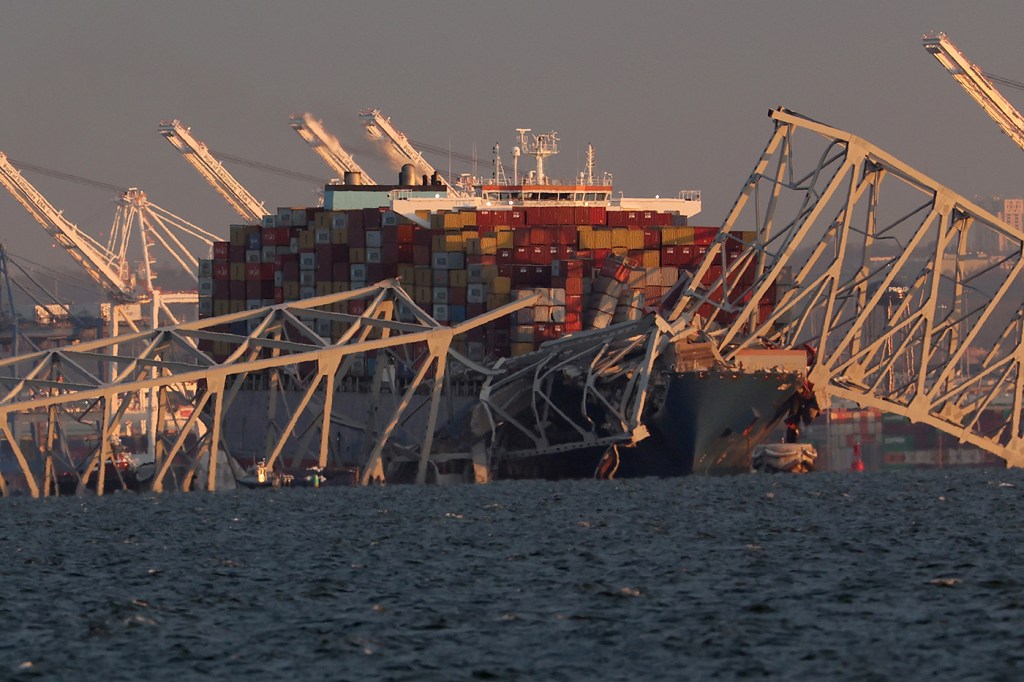On Tuesday morning, a container ship collided with a significant bridge in Baltimore, resulting in its collapse.

According to reports, a catastrophic collapse resulted in cars plunging into the water, prompting a coordinated emergency response from state authorities, emergency personnel, and the Coast Guard.
Although two individuals were rescued from the water, six others remained missing as of Tuesday afternoon. All of them were members of a construction crew tasked with repairing potholes.
It is believed that no individuals were inside the vehicles that plunged into the water. The container ship’s distress call prompted the suspension of traffic heading towards the bridge.
Jerome Hajjar, the CDM Smith Professor of Civil and Environmental Engineering at Northeastern University and the current president of the Structural Engineering Institute of the American Society of Civil Engineers, suggests that the collapse underscores the lack of foresight in older bridge designs regarding the increasing size of commercial shipping vessels over time.
He suggests that the bridge failure might have occurred due to a discrepancy between the load size or the force of the ship collision and the anticipated loads during the bridge’s design phase. “This event is undeniably tragic,” Hajjar conveys to Northeastern Global News. Footage of the collapse depicted a ship striking a bridge pillar, subsequently causing it to yield and collapse into the water.
“The container ship likely inflicted significant damage to the support structure. Given the span of the bridge, any substantial disruption or displacement of this support structure could lead to bridge failure,” explains Hajjar. “Should the support structure fail, the distance to the next supports on either side is too great to prevent the bridge from collapsing.”
He adds, “It’s conceivable that the failure of the support also dragged down the bridge. However, even if the bridge was merely relying on it, the failure of the support causing a significant downward deflection is sufficient to trigger collapse.”
The Francis Scott Key Bridge, an integral component of Interstate 695, is recognized by the American Society of Civil Engineers as the third longest continuous-truss bridge span globally, maintaining its position since its completion in 1977.
The Singapore-flagged cargo ship, named Dali, reportedly collided with a pillar of the bridge around 1:30 a.m., according to the New York Times. The owners of the 948-foot-long vessel stated that no injuries were reported among the ship’s crew.
Hajjar suggested that determining the structural integrity of the bridge is challenging. “It’s difficult to ascertain whether the bridge was structurally deficient,” he remarked. “When considering the impact of a large container ship colliding with a support, it’s plausible that the bridge itself wasn’t deficient.”
Hajjar noted that commercial ships, especially in major ports, frequently navigate bridges of comparable length to the Francis Scott Key Bridge.
Hajjar cannot comment on the specific design details of the Francis Scott Key Bridge. However, he suggests that such structures are typically engineered to endure lateral loads. Hence, he presumes that the magnitude of this particular load exceeded standard design parameters.
“And hence, I would presume that this burden exceeded the usual design thresholds,” he remarks.
Scouring, the erosion of soil around a bridge’s foundation, stands as the most prevalent cause of bridge failures.
“If the bridge’s foundation had been subjected to scouring over the years—where the force of water flow deteriorates the soil conditions around the base—then it’s conceivable that even a lighter load could trigger such an event,” Hajjar explains. “However, it’s challenging to ascertain definitively given the substantial magnitude of this load.”
As global demand for goods continues to rise, commercial container ships have progressively increased in size, resulting in heightened navigational complexities and potential risks, according to Hajjar.
“Typically, instances of failures, especially concerning bridges, are often associated with aging infrastructure,” notes Hajjar. “However, in this case, that may not be the primary factor. The disparity between the size of the cargo and the anticipated loads during the bridge’s design phase could be a significant factor.”
Furthermore, Hajjar emphasizes, “Any collapse of this nature is treated with utmost seriousness by the structural engineering community. We delve into these incidents meticulously, sometimes spanning years, to thoroughly understand every aspect.”
Read More: Riley Strain’s body discovered in Cumberland River
Disclaimer:
This content is AI-generated using IFTTT AI Content Creator. While we strive for accuracy, it’s a tool for rapid updates. We’re committed to filtering information, not reproducing or endorsing misinformation. – Jomotoday for more information visit privacy policy






Leave a Comment